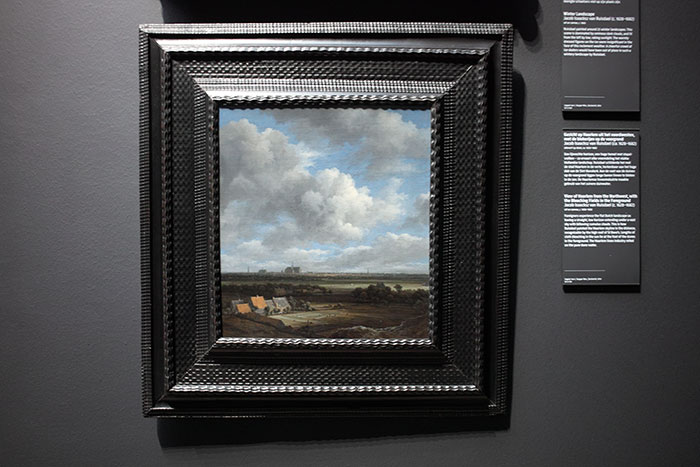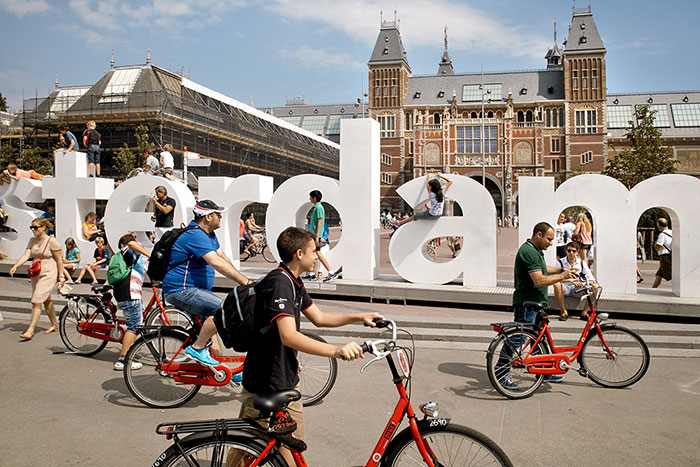 The Rijksmuseum seen through “iamsterdam” promotional sculpture — © Brian Rose
The Rijksmuseum seen through “iamsterdam” promotional sculpture — © Brian Rose
After almost two weeks of superb weather on Texel, the North Sea Dutch island, we headed for Amsterdam for two days before returning to New York. For many years, both the Rijksmuseum and the Stedelijk Museum have been undergoing extensive renovations and were closed. Imagine if the Metropolitan Museum and the Museum of Modern Art were closed at the same time for the better part of a decade. This was not a good thing for a city trying to promote itself as a cultural capital — well, at least they had Van Gogh. But the good news is that both museums have reopened.
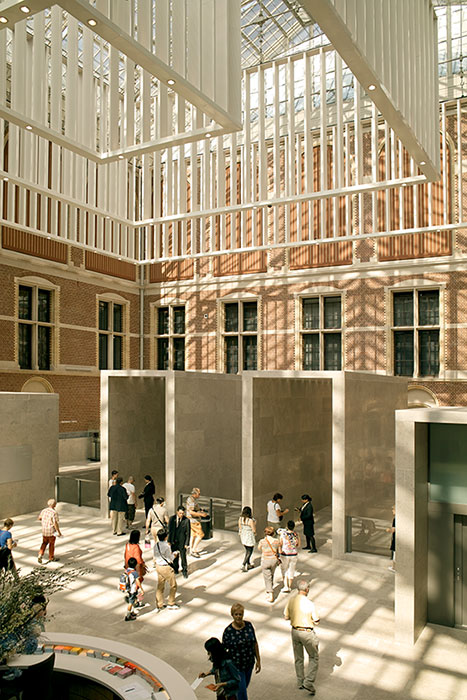
New entry courtyard in Rijksmuseum — © Brian Rose
The Rijksmuseum desperately needed upgrading. It occupied a decorative 19th century building by Pierre Cuypers, in the same style as his Central Station at the foot of the Damrak. It was a worthy home for the superb collection of Rembrandts and Vermeers, among others, but it was hopelessly outmoded as a contemporary museum, and could scarcely handle the ever increasing hordes of tourists hell bent on seeing the Nightwatch and checking it off on their to do list.
The reconstruction of the museum was delayed for years by a controversy involving bicycles — I kid you not. For decades one of the main bike routes through the center of the city passed directly through a passage in the Rijksmuseum. When the architects of the renovation proposed rerouting the bikes, they were met by the fury of the Amsterdam bicycle lobby, a group comparable in power to the military industrial complex in the United States. The solution was elegant — tunneling under the passage — but cost time and an ungodly amount of money. In the photo above, you can see visitors entering the museum through one of the impressive glass enclosed courtyards created by the Spanish firm Cruz y Ortiz Arquitectos.
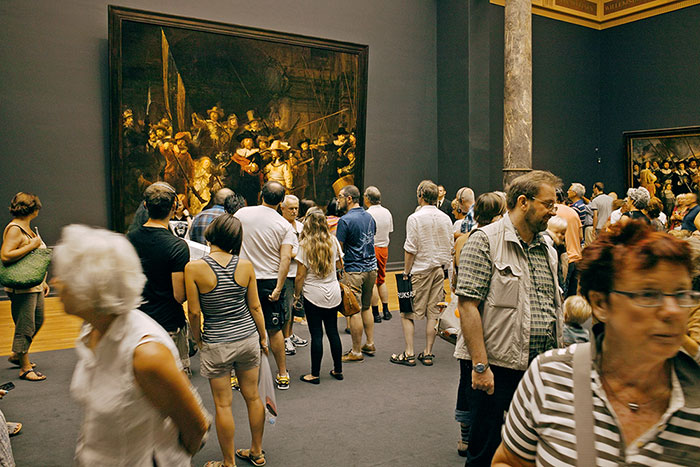 Rembrandt’s Nightwatch — © Brian Rose
Rembrandt’s Nightwatch — © Brian Rose
Once inside, the galleries have been beautifully refurbished by French interior architect Jean-Michel Wilmotte. The art mobs gravitate to Rembrandt’s Nightwatch — seen above — and press in relentlessly to see the relatively tiny Vermeers. But the museum is pretty big, so there are lots of galleries that are not crowded.
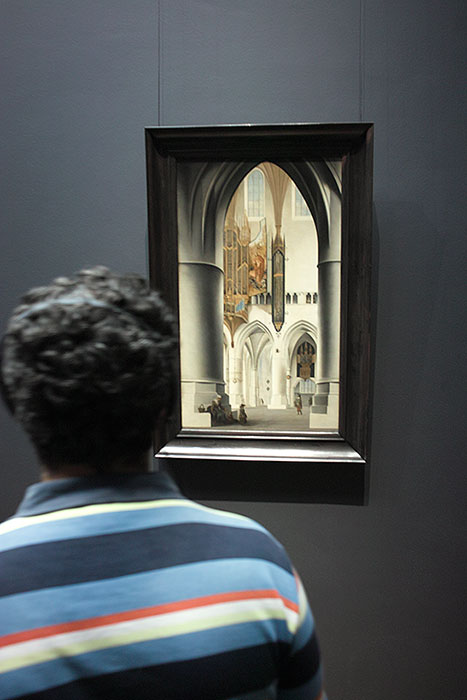
Jocob Saenredam — © Brian Rose
Here I am looking at one Saenredam’s architectural paintings made as if he were using a view camera.
And Ruisdael, who in this painting framed the endlessly horizontal Dutch landscape near Haarlem with a near square, the sky taking up 3/4 of the composition.
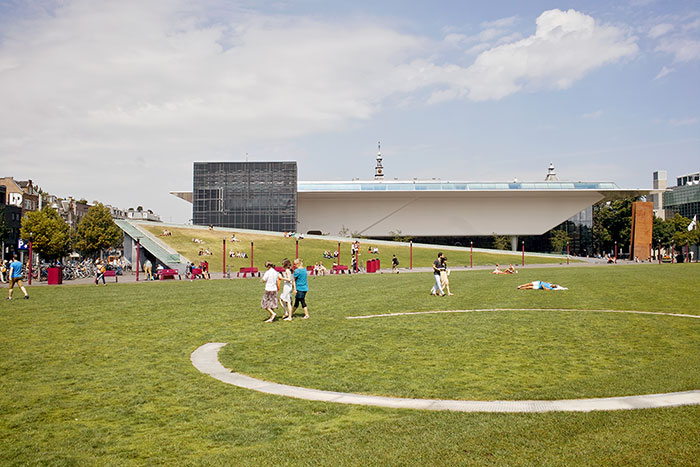 The Stedelijk Museum seen from Museumplein — © Brian Rose
The Stedelijk Museum seen from Museumplein — © Brian Rose
The first time I visited Amsterdam was in 1985 when I was just beginning my photographic journeys along the former Iron Curtain. The Stedelijk made a major impression on me in that it presented a view of modern art history that differed greatly from the linear narrative of MoMA in New York. It was all over the map, and challenged the idea that art develops as some kind of grand procession, one thing leading to the next, as if it were all inevitable. That said, I’ve come to appreciate the Modern’s effort to organize and make sense of things chronologically and stylistically.
Unlike MoMA, which was housed in a modernist collection of buildings, the Stedelijk was confined to a 19th century art palace with a grand staircase and comfortable, but inflexible, galleries. Like the Rijksmuseum nearby, it had inadequate accommodation for large crowds of visitors and little space for a shop and cafe. With one of the best collections of modern art in the world, it was obvious that something needed to be done.
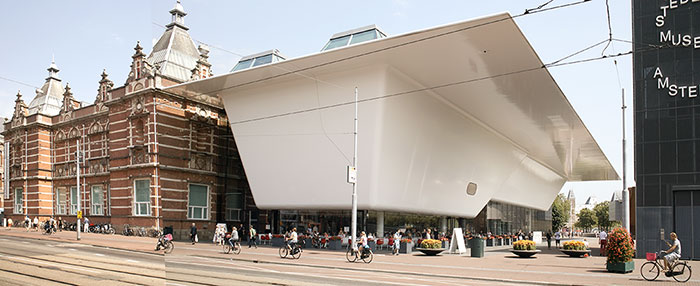 The Stedelijk Museum from the Van Baerlestraat — © Brian Rose
The Stedelijk Museum from the Van Baerlestraat — © Brian Rose
And here begins a sad tale of political and organizational dysfunction terminating in the “the bathtub” seen above in my quickly stitched together panorama. Read Michael Kimmelman’s Times article for the full story. The new wing of the museum faces the Museumplein, a desultory sward of grass punctuated by paved vectors and shapes, including the infamous “donkey’s ear,” a peeled up corner of the park serving as the entrance to underground parking and an Albert Heijn supermarket — the perfect location for groceries — smack dab between the stately Concertgebouw concert hall and the Stedelijk.
The new wing is mostly diffuse empty space, which will allow the museum to mount the kind of installation art now in favor around the globe. Such an installation was on view in the enormous basement space — a windowless art dungeon — where multiple videos by Aernout Mik were on display set among an intentionally disorienting maze of passageways and spaces. The show was appropriately sponsored by Ahold, the company that owns the Albert Heijn supermarket just out the front door of the museum. See Times review of Mik’s work here.
There are lots of wonderful things to see in the Stedelijk, regardless of the new building. But after everything, the architectural confection of the Rijksmuseum and the empty calories of the Stedelijk, all the hundreds of millions of dollars, coming back home to New York, the one thing that made the most impression on me, was that little Ruisdael painting, just over a foot square, sunlight breaking through the clouds.
